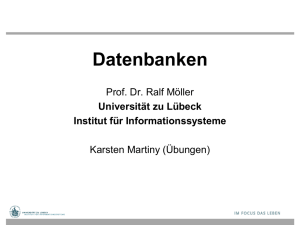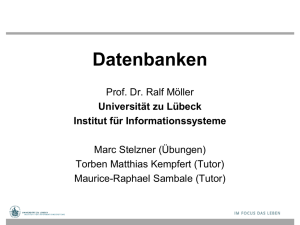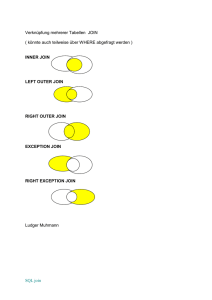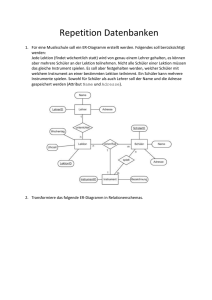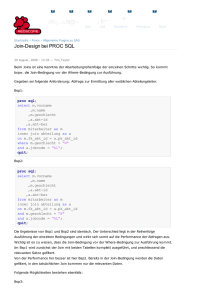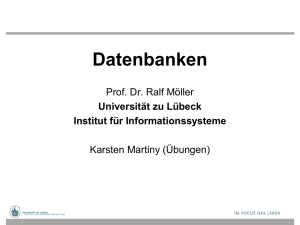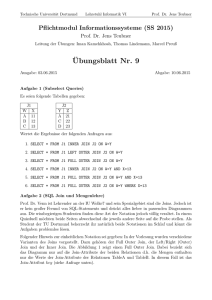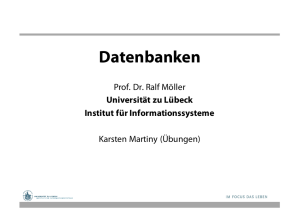ppt - Institut für Informationssysteme
Werbung
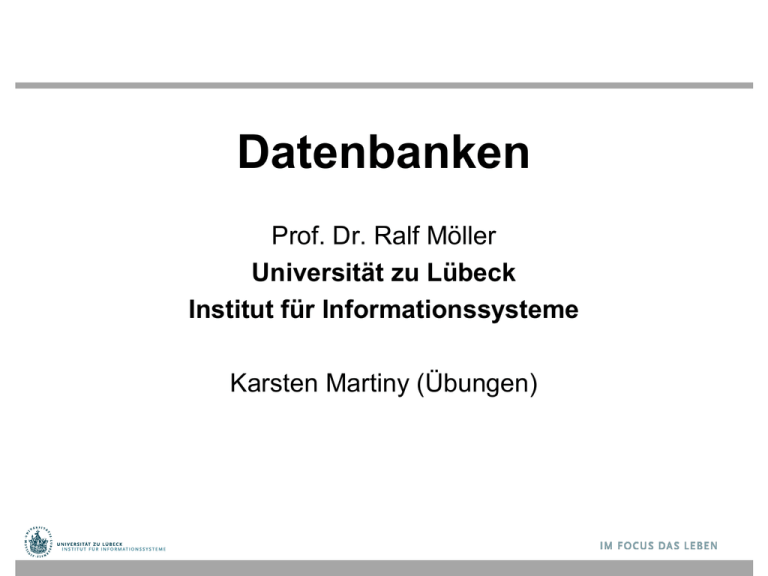
Datenbanken
Prof. Dr. Ralf Möller
Universität zu Lübeck
Institut für Informationssysteme
Karsten Martiny (Übungen)
Anfrageoptimierung
Architecture of a DBMS / Course Outline
Applications
Anwendungen
SQL
Interface
SQL-Schnittstelle
Figure inspired by Ramakrishnan/ Gehrke: “Dat abase Management Systems”, McGraw-Hill 2003.
Webformulare
Web
Forms
Ausführer
Executor
Parser
Parser
Operator
Evaluator
Operator-Evaluierer
Optimizer
Optimierer
Transaction
Transaktions
Manager
Dateiverwaltungsund Zugriffsmethoden
Files and Access
Methods
Verwalter
Puffer-Verwalter
Buffer
Manager
Lock
SperrVerwalter
Manager
Verwalter
für Manager
externen
Disk
Space
RWiederecovery
herstellungsManager
Verwalter
dieser Teil des
thiscourse
Kurses
SQL-Kommandos
SQLCommands
Speicher
DBMS
Dateien
für Daten
und Indexe...
data
files,
indices,
Fall 2008
Datenbank
Database
Systems Group — Department of Computer Science — ETH Zürich
3
2
Danksagung
• Diese Vorlesung ist inspiriert von den Präsentationen
zu dem Kurs:
„Architecture and Implementation of Database
Systems“
von Jens Teubner an der ETH Zürich
• Graphiken und Code-Bestandteile wurden mit
Zustimmung des Autors (und ggf. kleinen
Änderungen) aus diesem Kurs übernommen
3
Anfrageoptimierung
Finding the “Best” Query Plan
⇡
SELECT · · ·
FROM · · ·
WHERE · · ·
1 NL
?
1 hash
R
T
σ
S
• Es gibt mehr als eine Art, eine Anfrage zu
Ibeantworten
We already saw that there may be more than one way to
answer a given query.
– Welche Implementation eines Verbundoperators?
I
Which one of the join operators should we pick? With
– Welche
für Blockgrößen,
Pufferallokation,
which Parameter
parameters (block
size, buffer allocation,
...)?
... task of finding the best execution plan is, in fact, the
I The
grail of any database
implementation.
–holy
Automatisch
einen Index
aufsetzen?
Systems Group — Department of Computer Science — ETH Zürich
•Fall 2008
Die Aufgabe,
den besten Ausführungsplan zu
finden, ist der heilige Gral der
161
4
Finding the right plan can dramatically impact performance.
Auswirkungen
auf
die
Performanz
SELECT L. L PARTKEY, L. L QUANTI TY, L. L EXTENDEDPRI CE
FROM LI NEI TEM L, ORDERS O, CUSTOMER C
SELECT L.L_PARTKEY, L.L_QUANTITY, L.L_EXTENDEDPRICE
WHFROM
ERELINEITEM
L. L ORD
ERORDERS
KEY =O,O.CUSTOMER
O ORDER
L,
CKEY
WHERE
= O.O
AND L.L
O. OORDERKEY
CUSTKEY
= CORDERKEY
. C CUSTKEY
AND O.O_CUSTKEY = C.C_CUSTKEY
AND AND
C. CC.C_NAME
NAME == ’ ’IBM
I BMCorp.’
Cor p. ’
57
57
1
1
6 mio
1
6 mio
L
I•
Fall 2008
1.5mio
O
σ
1
150,000
C
150,000
σ
1
1
14
6 mio
1.5mio
L
O
C
In
terms ofauf
execution
times, these differences
Bezogen
die Ausführungszeit
können can
die easily
mean
“seconds „Sekunden
versus days.”vs. Tage“ bedeuten
Unterschiede
Systems Group — Department of Computer Science — ETH Zürich
163
5
Abschätzung
der Ergebnisgröße
esult
Size Estimation
Consider
a query
block corresponding
to a simple SFW query Q.
Betrachte
Anfrageblock
für Select-From-WhereAnfrage Q
⇡ proj-list
σpredicate-list
⇥
R1
R2
···
Rn
WeAbschätzung
can estimate the
size of Q based
derresult
Ergebnisgröße
von on
Q durch
I the size of the input tables, |R1|, . . . , |Rn |, and
•die Größe der Eingabetabellen |R1|, |R2|, ... ,|Rn| und
I •die
theSelektivität
selectivity sel(p)
of the predicate predicate-list :
sel(predicate-list)
|Q| = |R1| ∙ |R2| ∙ ... ∙ |Rn| ∙
|Q| ⇡ |R1| · |R2| · · · |Rn | · sel(predicate-list ) .
6
Tabellenkardinalitäten
• Die Größe einer Tabelle ist über den Systemkatalog
verfügbar (hier IBM DB2)
db2 => SELECT TABNAME, CARD, NPAGES
db2 (cont.) => FROM SYSCAT.TABLES
db2 (cont.) => WHERE TABSCHEMA = 'TPCH';
TABNAME
CARD
NPAGES
-------------- -------------------- -------------------ORDERS
1500000
44331
CUSTOMER
150000
6747
NATION
25
2
REGION
5
1
PART
200000
7578
SUPPLIER
10000
406
PARTSUPP
800000
31679
LINEITEM
6001215
207888
8 record(s) selected.
7
Abschätzung der Selektivität
Estimating Selectivities
...
durch Induktion
über
Struktur
des
Anfrageblocks
To estimate
the selectivity
of a die
predicate,
we look
at its
structure.
column = value
⇢
sel(·) =
1/ |I|
1/ 10
es einen
iffalls
there
is an Index
indexI Iauf
on Attribut
columncolumn gibt
sonst
otherwise
column1 = column
2
8
1
>
< max{ |I1|,|I2|}
1
sel(·) =
|I |
>
: 1k
/ 10
es Indexe
auf beiden
Spalten
iffalls
there
are indexes
on both
cols.gibt
es einen
Index nur
iffalls
there
is an index
onlyauf
oncolumn
col. k gibt
sonst
otherwise
p1 ANDp2
sel(·) = sel(p1) · sel(p2)
p1 ORp2
sel(·) = sel(p1) + sel(p2) − sel(p1) · sel(p2)
Fall 2008
Systems Group — Department of Computer Science — ETH Zürich
169
8
Verbesserung der Selektivitätsabschätzung
• Annahmen
– Gleichverteilung der Datenwerte in einer Spalte
– Unabhängigkeit zwischen einzelnen Prädikaten
• Annahmen nicht immer gerechtfertigt
• Sammlung von Datenstatistiken (offline)
– Speicherung im Systemkatalog
• IBM DB2: RUNSTATS ON TABLE
– Meistverwendet: Histogramme
9
Histogramme
SELECT SEQNO, COLVALUE, VALCOUNT
FROM SYSCAT.COLDIST
WHERE TABNAME = 'LINEITEM'
AND COLNAME = 'L_EXTENDEDPRICE'
AND TYPE = 'Q';
SEQNO COLVALUE
VALCOUNT
----- ----------------- -------1
+0000000000996.01 3001
2
+0000000004513.26 315064
3
+0000000007367.60 633128
4
+0000000011861.82 948192
5
+0000000015921.28 1263256
6
+0000000019922.76 1578320
7
+0000000024103.20 1896384
8
+0000000027733.58 2211448
9
+0000000031961.80 2526512
10
+0000000035584.72 2841576
11
+0000000039772.92 3159640
12
+0000000043395.75 3474704
13
+0000000047013.98 3789768
SYSCAT.COLDIST
enthält Informationen wie
• n-häufigste Werte (und
deren Anzahl)
• Auch Anzahl der
verschiedenen Werte
pro Histogrammrasterplatz anfragbar
Tatsächlich können
Histo-gramme auch
absichtlich gesetzt
werden, um den
10
Optimierer
zu
DB2: TYPE='Q' Quantile (cumulative distribution),
TYPE='F' Frequency
product with a number of selection predicates on top.
I We can estimate the cost of a given execution plan.
Verbund-Optimierung
I
Use result size estimates in combination with the cost
for individual
join algorithms
in the previous
chapter.
Auflistung
der möglichen
Ausführungspläne,
d.h.
We
are3-Wege-Verbundkombinationen
now ready to enumerate all possible
plans, i.e.,
alle
fürexecution
jeden Block
all possible 3-way join combinations for each query block.
1
1
R
1
1
T
S
S
1
S
Fall 2008
1
T
R
R
1
1
R
T
R
1
S
S
T
1
1
S
1
1
T
T
1
R
T
T
1
1
R
S
T
1
S
T
R
1
1
S
1
1
S
R
S
1
1
T
R
1
T
S
Systems Group — Department of Computer Science — ETH Zürich
S
R
172
11
Suchraum
•Search
Der sich
ergebende Suchraum ist enorm groß:
Space
The resulting
search
space is enormous:
Schon
bei 4
Relationen
ergeben sich 120
Möglichkeiten
number of relations n
2
3
4
5
6
7
8
10
Cn− 1
join trees
1
2
5
12
14
120
42
1,680
132
30,240
429
665,280
1,430
17,297,280
16,796 17,643,225,600
And we haven’t yet even considered the use of k different
(n− 1)
join
algorithms
(yielding
another
factor
of
k
)!
Noch nicht berücksichtigt: Anzahl v der
I
•
verschiedenen Verbundalgorithmen
Fall 2008
Systems Group — Department of Computer Science — ETH Zürich
175
12
Dynamische Programmierung
• Beispiel 4-Wege-Verbund
• Sammle gute Zugriffspläne für Einzelrelation (z.B.
auch mit Indexscan und mit Ausnutzung von
Ordnungen)
P.G. Selinger, M.M. Astrahan, D.D. Chamberlin, R.A. Lorie and
T.G. Price, Access path selection in a relational database
management system, In Proc. ACM SIGMOD Conf. on the
Management of Data, pages 23-34, 1979
13
Beispiel: 4-Wege-Verbund
Example: Four-Way Join
Pass 1 (best 1-relation plans)
Find the
best
accesspath
to each
of the
Ri individually
a set
of good
access paths
to each
of the
(considers index scans, full table scans)., interesting orders)
Pass 2 (best 2-relation plans)
For each pair of tables Ri and Rj , determine the best order to
join Ri and Rj (Ri 1 Rj or Rj 1 Ri ?):
optPlan({ Ri , Rj } )
best of Ri 1 Rj and Rj 1 Ri .
! 12 plans to consider.
Pass 3 (best 3-relation plans)
For each triple of tables Ri , Rj , and Rk, determine the best
three-table join plan, using sub-plans obtained so far:
optPlan({ Ri , Rj , Rk} )
best of Ri 1 optPlan({ Rj , Rk} ),
optPlan({ Rj , Rk} ) 1 Ri , Rj 1 optPlan({ Ri , Rk} ), . . . .
! 24 plans to consider.
Fall 2008
Systems Group — Department of Computer Science — ETH Zürich
177
14
Beispiel(cont.)
(Fortsetzung)
Example
Pass 4 (best 4-relation plan)
For each set of four tables Ri , Rj , Rk, and Rl , determine the
best four-table join plan, using sub-plans obtained so far:
optPlan({ Ri , Rj , Rk, Rl } )
best of Ri 1 optPlan({ Rj , Rk, Rl } ),
optPlan({ Rj , Rk, Rl } ) 1 Ri , Rj 1 optPlan({ Ri , Rk, Rl } ), . . . ,
optPlan({ Ri , Rj } ) 1 optPlan({ Rk, Rl } ), . . . .
! 14 plans to consider.
I Overall, we looked at only 50 (sub-)plans (instead of the
• Insgesamt:
50 (Unter-)Pläne betrachtet (anstelle von
120 four-way join plans; % slide 175).
120possible
möglichen
4-Wege-Verbundplänen, siehe
I All decisions required the evaluation of simple sub-plans
Tabelle)
only (no need to re-evaluate the interior of optPlan(·)).
• Alle Entscheidungen basieren auf vorher
Unterplänen
(keine
Neuevaluierung
von
Fallbestimmten
2008
Systems
Group — Department of Computer
Science
— ETH Zürich
178
Plänen)
15
Links-tiefe
vs. buschige
VerbundplanLeft/Right-Deep
vs. Bushy Join
Trees
The algorithm on slide 179 explores all possible shapes a join tree
Bäume
could take:
1
···
1
···
1
···
1
1
···
left-deep
1
1
···
···
··· ··· ··· ···
bushy
(everything else)
1
1
···
···
right-deep
Actual systems often prefer left-deep join trees.11
Implementierte
generieren
I The innerSysteme
relation is always
a base relation. meist links-tiefe
Pläne1 I Allows the use of index nested loopsjoin.
I Easier to implement in a pipelined fashion.
•Die innere Relation ist immer eine Basisrelation
The seminal System Rprototype, e.g., considered only left-deep plans.
•Bevorzugung der Verwendung von Index-Verbunden
•Gut geeignet für die Verwendung von PipelineVerarbeitungsprinzipien
11
Systems Group — Department of Computer Science — ETH Zürich
Fall 2008
1
So z.B. der Prototyp von System R (IBM)
181
16
Verbund über mehrere Relationen
• Dynamische Programmierung erzeugt in diesem
Kontext exponentiellen Aufwand [Ono & Lohmann,
90]
– Zeit: O(3n)
– Platz: O(2n)
• Das kann zu teuer sein...
– für Verbunde mit mehreren Relationen (10-20 und
mehr)
– für einfache Anfragen über gut-indizierte Daten, für
die ein sehr guter Plan einfach zu finden wäre
• Neue Plangenerierungsstrategie:
Greedy-Join-Enumeration
K. Ono, G.M. Lohman, Measuring the Complexity of
Join Enumeration in Query Optimization, VLDB 1990
17
Greedy-Join-Enumeration
Greedy Join Enumeration
1
Function: f i nd j oi n t r ee gr eedy ( q(R1, . . . , Rn ))
worklist
? ;
3 for i = 1to n do
4
worklist
worklist [ best access pl an ( Ri ) ;
2
for i = n downto 2 do
/ / worklist = { P1, . . . , Pi }
6
find Pj , Pk 2 worklist and 1 ... such that cost(Pj 1 ... Pk) is minimal ;
7
worklist
worklist \ Pj , Pk [
Pj 1 ... Pk ;
5
/ / worklist = { P1}
8 return single plan left in worklist ;
I In each
choose the
cheapest
join that can be made
• Wähle
in iteration,
jeder Iteration
den
kostengünstigsten
Plan,
theden
remaining
sub-plans.Unterplänen zu realisieren
derover
über
verbliebenen
I Observe that f i nd j oi n t r ee gr eedy ( ) operates similar to
ist
finding the optimum binary tree for Huffman coding.
18
Fall 2008
Systems Group — Department of Computer Science — ETH Zürich
185
Prädikatsvereinfachung
Beispiel: Schreibe
SELECT *
FROM LINEITEM L
WHERE L.L_TAX * 100 < 5
um in
SELECT *
FROM LINEITEM L
WHERE L.L_TAX < 0.05
•Prädikatsvereinfachung ermöglicht Verwendung von
Indexen und Vereinfacht die Erkennung von effizienten
Verbundimplementierungen
19
Zusätzliche Verbundprädikate
Implizite Verbundprädikate wie in
SELECT *
FROM A, B, C
WHERE A.a = B.b AND B.b = C.c
können explizit gemacht werden
SELECT *
FROM A, B, C
WHERE A.a = B.b AND B.b = C.c AND A.a = C.c
Hierdurch werden Pläne möglich wie (A ⋈ C) ⋈ B
20
Geschachtelte Anfragen
SQL bietet viele Wege, geschachtelte Anfrage zu
schreiben
•Unkorrelierte
Unteranfragen
SELECT *
FROM ORDERS O
WHERE O_CUSTKEY IN (SELECT C_CUSTKEY
FROM CUSTOMER
WHERE C_NAME = ‘IBM Corp.‘)
•Korrelierte
SELECT * Unteranfragen
FROM ORDERS O
WHERE O_CUSTKEY IN (SELECT C.C_CUSTKEY
FROM CUSTOMER
WHERE C.C_ACCTBAL = O.O_TOTALPRICE)
Won Kim. On Optimizing an SQL-like Nested Query.
ACM TODS, vol. 7, no. 3, 1982
21
Zusammenfassung
• Anfrageparser
– Übersetzung der Anfrage in Anfrageblock
• Umschreiber
– Logische Optimierung (unabhängig vom DB-Inhalt)
– Prädikatsvereinfachung
– Anfrageentschachtelung
• Verbundoptimierung
– Bestimmung des „günstigsten“ Plan auf Basis
• eines Kostenmodells (I/O-Kosten, CPU-Kosten) und
• Statistiken (Histogramme) sowie
• Physikalischen Planeigenschaften (interessante
Ordnungen)
– Dynamische Programmierung, Greedy-Join
22
Noch zu diskutieren...
Architecture of a DBMS / Course Outline
Applications
Anwendungen
SQL
Interface
SQL-Schnittstelle
Figure inspired by Ramakrishnan/ Gehrke: “Dat abase Management Systems”, McGraw-Hill 2003.
Webformulare
Web
Forms
Ausführer
Executor
Parser
Parser
Operator
Evaluator
Operator-Evaluierer
Optimizer
Optimierer
Transaction
Transaktions
Manager
Dateiverwaltungsund Zugriffsmethoden
Files and Access
Methods
Verwalter
Puffer-Verwalter
Buffer
Manager
Lock
SperrVerwalter
Manager
Verwalter
für Manager
externen
Disk
Space
RWiederecovery
herstellungsManager
Verwalter
dieser Teil des
thiscourse
Kurses
SQL-Kommandos
SQLCommands
Speicher
DBMS
Dateien
für Daten
und Indexe...
data
files,
indices,
Fall 2008
Datenbank
Database
Systems Group — Department of Computer Science — ETH Zürich
3
23
